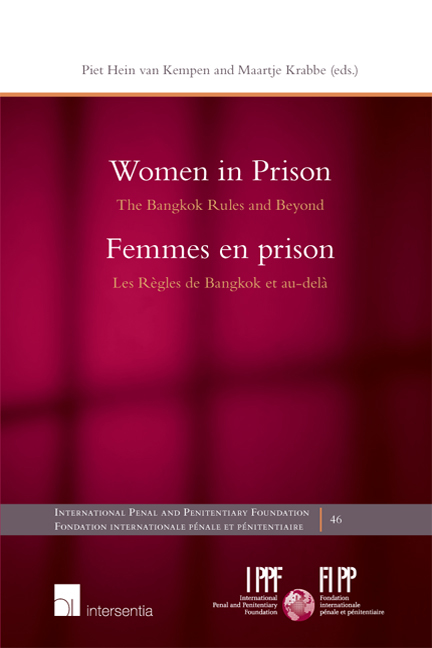Book contents
- Frontmatter
- Foreword
- Avant-propos
- Acknowledgements
- Remerciements
- Contents
- Part I Introductory Synthesis and Analyses: 1ÈRE Partie Synthèse ET Analyses Introductives
- Part II Themes: 2ÈME Partie Thèmes
- Women, crime and incarceration: exploring pathways of women in conflict with the law – The case of South Africa
- Variations and growth in the levels of female imprisonment
- Protection of women in prison under the European Convention on Human Rights
- European standards relating to non-judicial protection of women in prison
- Protection of women in prison in Asia: positive developments, weaknesses, opportunities and threats – perspectives from UNAFEI and its participating countries
- Implementation of the Bangkok Rules in Thai prisons
- The design of women's prisons: an architectural perspective on gender-specific needs and realities of female prisoners and main requirements for improvement
- Part III National Reports: 3ÈME Partie Rapports Nationaux
- Appendix The Bangkok Rules: Annexe Règles De Bangkok
- The International Penal and Penitentiary Foundation: History and Purpose
The design of women's prisons: an architectural perspective on gender-specific needs and realities of female prisoners and main requirements for improvement
from Part II - Themes: 2ÈME Partie Thèmes
Published online by Cambridge University Press: 25 September 2018
- Frontmatter
- Foreword
- Avant-propos
- Acknowledgements
- Remerciements
- Contents
- Part I Introductory Synthesis and Analyses: 1ÈRE Partie Synthèse ET Analyses Introductives
- Part II Themes: 2ÈME Partie Thèmes
- Women, crime and incarceration: exploring pathways of women in conflict with the law – The case of South Africa
- Variations and growth in the levels of female imprisonment
- Protection of women in prison under the European Convention on Human Rights
- European standards relating to non-judicial protection of women in prison
- Protection of women in prison in Asia: positive developments, weaknesses, opportunities and threats – perspectives from UNAFEI and its participating countries
- Implementation of the Bangkok Rules in Thai prisons
- The design of women's prisons: an architectural perspective on gender-specific needs and realities of female prisoners and main requirements for improvement
- Part III National Reports: 3ÈME Partie Rapports Nationaux
- Appendix The Bangkok Rules: Annexe Règles De Bangkok
- The International Penal and Penitentiary Foundation: History and Purpose
Summary
INTRODUCTION
Currently, the architecture of prisons for women does not generally correspond to the needs and characteristics of the female prison population. This situation becomes more apparent in the light of the Bangkok Rules. Nevertheless, there have been remarkable improvements in this field, which, if applied on a large scale, would introduce relevant improvements in women's accommodation conditions.
This chapter will first provide some background on the architecture of female prisons and on some characteristics of the female prison population (section 2). The Bangkok Rules as they relate to prison design are then described (section 3). Next we explore some of their consequences for the architecture of buildings for women (section 4). Lastly, we weigh up the good and bad practices in the field, in order to identify the main elements in need of improvement (section 5).
BACKGROUND
It is quite common in the penitentiary field to hear comments like “we would build the kind of prisons we always build and then we would look to see how to alter it for women”, or “there's a tendency to build male facilities without urinals and call them female facilities”. A prison is stereotypically masculine, so the physical and architectural elements that define it (walls, bars, cells and so on) are typical of buildings intended for men. As a consequence, most women's prisons are designed with these preconceptions. Regardless of whether the architectural program states the particular characteristics that a facility for women must meet, most of the time, the decisions on design are made resorting to solutions and forms that are typical of men's prisons.
However, the criminological characteristics of female offenders differ from those of male offenders. In general, they have been charged with non-violent crimes, have a record of abuse and addiction, precarious employment and a low level of education. Also, they have low self-esteem, are sentenced to short terms in prison, and most of them are mothers of children aged under 18. Women also show a different reaction to the prison environment: when they are under stress, they tend to be more cooperative rather than competitive, and they suffer emotional distress more frequently than men. These and other characteristics make the behavior of and the risks faced by female prisoners markedly different from those of men. Consequently, architectural solutions need to be different as well.
- Type
- Chapter
- Information
- Women in PrisonThe Bangkok Rules and Beyond, pp. 161 - 174Publisher: IntersentiaPrint publication year: 2017
- 1
- Cited by

